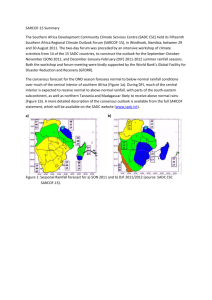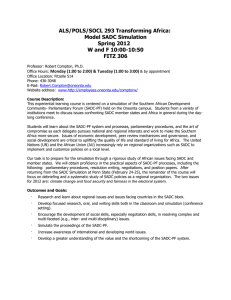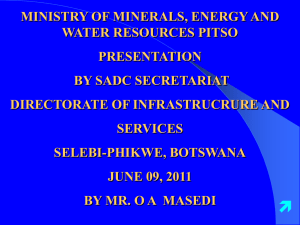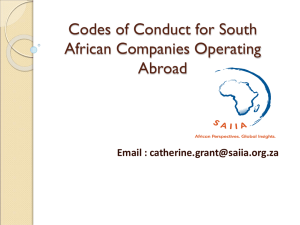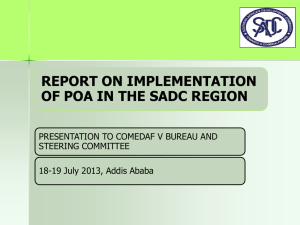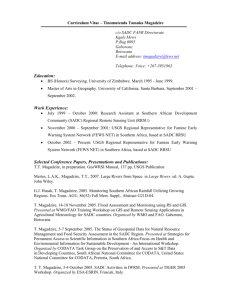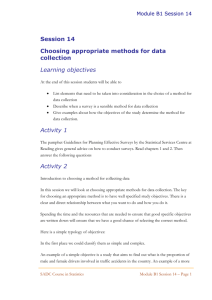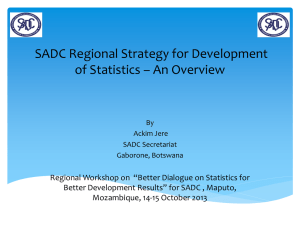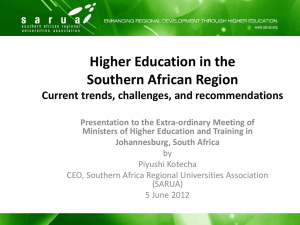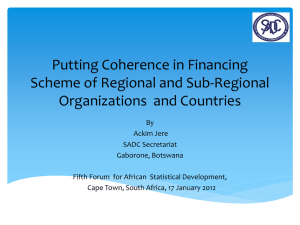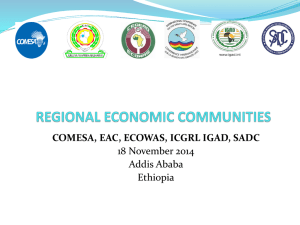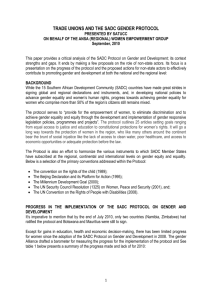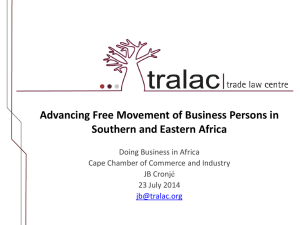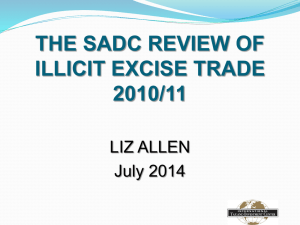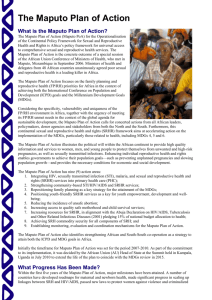PPT1
advertisement
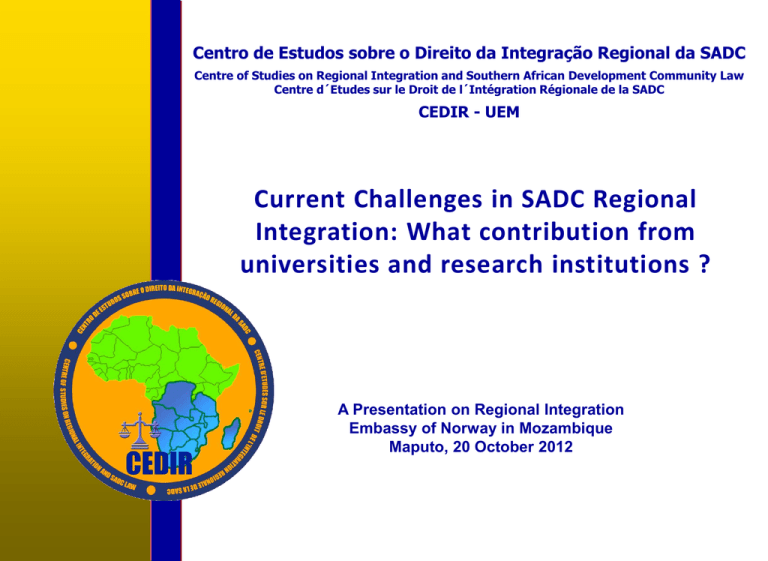
Centro de Estudos sobre o Direito da Integração Regional da SADC Centre of Studies on Regional Integration and Southern African Development Community Law Centre d´Etudes sur le Droit de l´Intégration Régionale de la SADC CEDIR - UEM Current Challenges in SADC Regional Integration: What contribution from universities and research institutions ? A Presentation on Regional Integration Embassy of Norway in Mozambique Maputo, 20 October 2012 Presentation Outline Introduction: Key facts about RI in Africa and in SADC Current challenges and issues Why should academics get involved ? CEDIR´s Regional Academic Network Mainstreaming RI and Harmonisation of Laws Conclusion. Introduction: Key facts on RI in Africa and SADC The African RI Roadmap • • • • • • The African Economic Community AEC (Abuja Treaty- 1991) adopted a six stages roadmap: Regional Economic blocks (RECs) – 1999 Strengthening intra REC integration and intro REC harmonisation – 2007 Establish a continent-wide Customs Union and FTA – 2019 African Common Market - 2023 African Economic and Monetary Union with single currency , plus the Pan African Parliament – 2028 Transitional Period for continental integration - 2034 at least Traditional RI Model Preferen tial Trade Area (PTA) Free Trade Area (FTA) Low Tariffs between members No Tariffs between members Customs Union (CU) Common Market Free Common movement External of factors of Tariffs production Economic Union Unified monetary and fiscal policies Political Union Ultimate stage: cession of sovereignty SADC -RI Roadmap SADC -RI Roadmap was defined by the RISDP (2003) 2008 Free Trade Area 2010 Customs Union 2015 Common Market 2018 Monetary Union SADC Legal instruments • Treaty (signed in Windhoek on 17 August 1999 and amended in Blantyre on 14 August 2001), • Protocols: (a total of 26) • Memoranda of Understanding (MoUs) • Charters, • Principles and Guidelines (democratic elections) • Declarations, Regulations and Guidelines, • Strategic Plans: RIDSP, SIPO Key facts: Historical legacy • Balkanisation of the African continent: 55 countries, fragmented and fragile economies (focus on fighting poverty rather than production). • Permanent situation of insecurity and conflicts: DR Congo, Madagascar, Mali, Guinée Bissau, Sudan, etc. • High dependence on agriculture for economic development and employment • Lack of adequate infrastructure: high costs of transport and communication, lack of education and low literacy level Key facts: Positive aspects • African Union recognised eight RECs as pillars of the AEC: CEN-SAD, COMESA, EAC, ECCAS/CEEAC (CEMAC), ECOWAS (UEMOA/WAMZ), IGAD, SADC (SACU), AMU/ UMA. • Tripartite FTA signed by COMESA, ESA and SADC: 26 countries representing half of the continent with a population of more 580 millions and a combined GDP of 700 Billions USD. • Emerging economies: 7 out of 10 world´s fastest growing economies are in Africa, the prospects of discoveries of extensive mineral resources all over the continent. • Need for a new development model and shift towards Market Integration, regional infrastructure and fast tract industrial development. Current Challenges Weak and ambitious RI agenda African RECs are characteries by : - Multiple and overlaping memberships (spaghetti) - Diverging roadmaps to integration and - Unequal levels of economic development, - Lack of commitment for implementation of protocols (no enforcement mechanisms) - Lack of harmonisation of policies: different institutional and legal systems, - Lack of regional drivers and Insufficient coordination at continental level (AUC). - The issue of state sovereignty . SADC low inclusiveness SADC R.I. process characteries by : - Top down approach (opposed to bottom-up) - Politically-led process: reserved for government officials and diplomats, - Missing links: limited involvement of national stakeholders (national parliaments, judiciary, adacemics, civil society, private sector) - Lack of ownership among the citizens, - Lack of accountability to the people and - Serious issues of human rights and governance External challenges Regional Integration policies in Africa are negatively affected by : - The globalisation process and its impacts, Global financial crisis: limited funding and FDI Lack of progress in WTO – DDA negotiations Risk of negative impact of EU – EPAs agreements (risk of desintegration). Why should academics get involved ? The growing importance of RI - Regional Integration has gained preeminence in the economic development discourse and strategies for Africa; - RI is strategic for African Economic Recovery; - Intra-REC trade has increased, investments and infrastructure development on rise. - The need to enhance knowledge development and research as tools for RI policy making: RI is moving at a faster pace (scientific footprint). The role of academic institutions - Need to recognise the role of universities and HE institutions as catalysers of regional development through education and research; - Unprecedented discoveries and latest developments in technology and knowledge management can bring positive change; - Universities are naturally and technically equipped to be knowledge depositories; - Need to use research for policy development. Opportunity to link knowledge and Policy - Universities should to become key players in policy making by creating and disseminating knowledge through accurate and scientifically credible evidence (as a tool for development); - Academics should promote debates / dialogue and create a better environment for a knowledge society in Africa, - The academic community should use its critical mass within the region and work harder to promote innovative research for development. Conclusion • Regional Integration has become too complex and too important to be ignored by scientists, • Academic institutions can use knowledge as a catalysor for faster development in Africa, • Globalisation and emerging issues need innovative solutions based on accurate research and taking advantages of new discoveries in technology, • Universities can contribute to raising awareness and enhancing a more inclusive RI agenda, • Need to learn from best cases and experiences worldwide (EU experience, ASEAN, Americas). References - Universidade Eduardo Mondlane (2008), Deliberation of the University Council, concerning the adoption of CEDIR´s Articles of Incorporation and Regulations (25-26 November 2008), Maputo. - Universidade Eduardo Mondlane (2008), Final Conclusions and Recommendations, First International Conference on Regional Integration and SADC Law (23 - 25 April 2008), Faculty of Law, Maputo. - CEDIR (2009), Proceedings from the First Consultative Meeting of CEDIR Partners and the Regional Academic Network (29 May 2009), Maputo, -CEDIR (2010), Strategic Plan for 2010 – 2014, working document, Maputo. -UNECA – CEDIR (2009), A Framework for Mainstreaming Regional Integration in National Development Plans in the Southern African Development Community (SADC), Lusaka / Maputo. - Economic Commission for Africa (2010), Assessing Regional Integration in Africa IV: Enhancing Intra-African Trade, ECA Policy Research Report. Addis Ababa, UNECA. THANK YOU FOR YOUR ATTENTION OBRIGADO - TAKK - TACK - GRACIAS DANK U - MERCI - SHUKRANI - KHANIMAMBO XIE XIE
